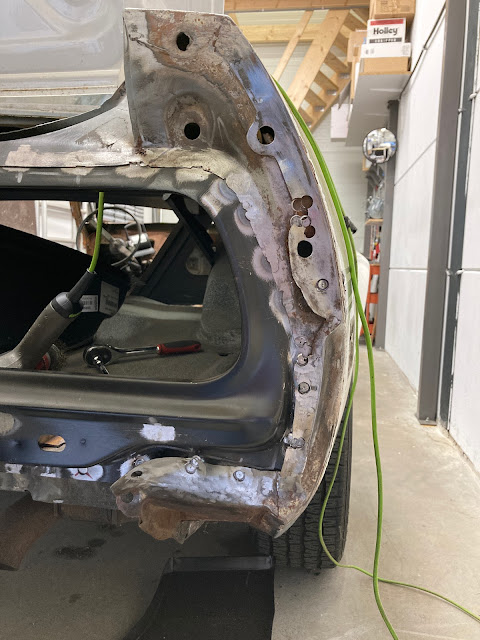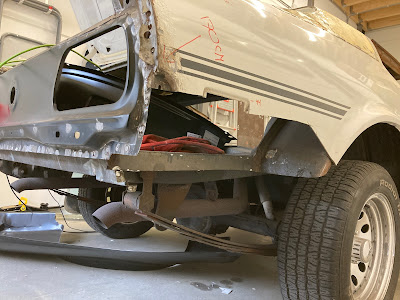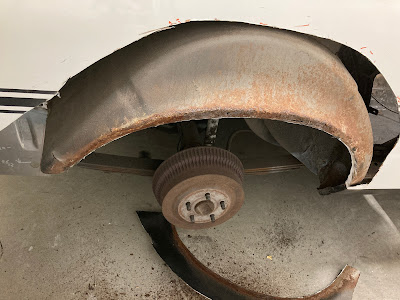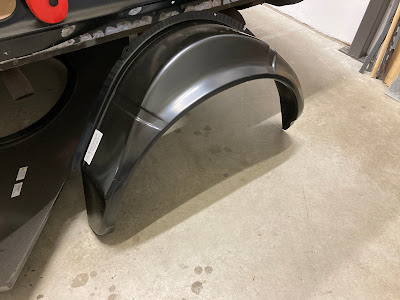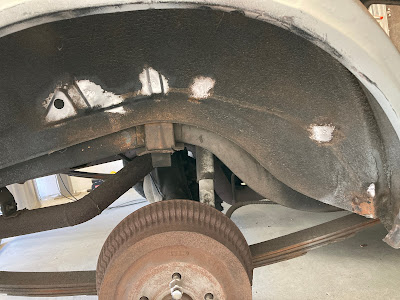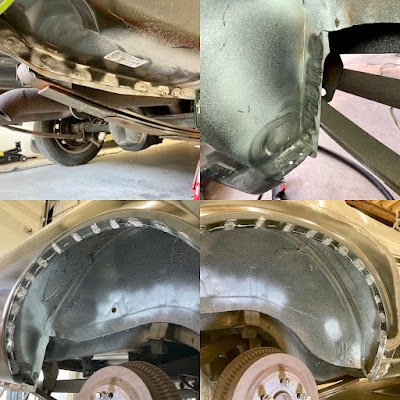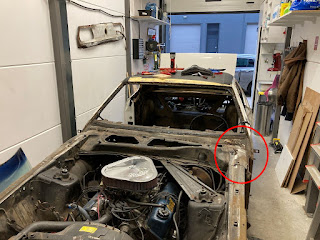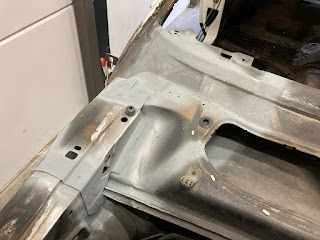So in the meantime I removed the hood, windshield and wipers and now (May 2021) it was time to inspect the cowl, that's the area under the windshield. It's a hollow space designed to let air into the car (through the heater or AC) and the early Mustangs usually get rust holes in several places there. I started inspection on the LH (Left Hand) side in the red circle below.
And sure enough it didn't take long before I found a hole when looking from inside the car. The shit show was about to start... It's a shit show because getting new cowl panels is too expensive which means I have to patch. And because I do not fancy welding upside down from inside the car I had to go in from the top, which in the end wasn't bad because I found more rust holes in the parts I needed to remove.
So this piece needs to be removed first which means drilling out about 25 spot welds in the shittest of places:
When removed the corner of the cowl shows itself, including unexpected extra rust holes where daylight hasn't been in nearly 50 years. Oh joy. Good times... Look:
To get to the main target area, the rust hole I spotted first from the inside, the corner needed to be cut open, showing a very crusty area:
The hole..
The metal around the hole was pretty pitted as well and beyond repair. So a larger patch was required. By now I had made a few patches so that wasn't too scary. I started putting duct tape on to create an overlay of the area to be patched:
I then created the patch out of an old piece of original sheet I cut out when working on the LH rear quarter. It worked out pretty OK:
Patch welded in place.
So, back to the corner. It appeared crustier than expected and it required 3 patches, one on each side:
One patch on the side was a bit challenging but fun to make:
And here the patched up corner is welded back in place and sprayed with 3M welding primer:
Finally the top could be welded back. But only after even that was patched:
This part of the cowl took a lot longer than I figured before I started but these old cars are just full of surprises. And then to think mine is in pretty OK condition!
Welding done at the end of August 2021.
Time to check out the other corner, same shit different location:
The RH (Right Hand) corner reveiling itself in all its crispy glory.
After cutting it open and drilling out close to 30 spotwelds:
There we go, the numero uno of places where old Mustangs rust out first, the AC/heater air intake. They rust around the hat but in my case also at the back. It showed when I took my carpet out because the floor underneath it is crusty as well....
So this needs to be taken out.
There is something hanging of the bottom that will be cut out. The heater attaches to this so it will need to be put back in place after the patch is in. So I marked its location as well as I could:
Now the rusted out area can be cut out, leaving a big hole to be patched:
This was a cool patch to make, the biggest I made so far and it turned out well. Because I'm going to put back in a newer type of heater that round hole is not required anymore:
Welded in place. It is important to make sure the water flows off of it. That's why the level is there:
Make sure all water that comes in, flows to the corner.
The top needed some work as well. Three patches in total:
This has gotta be one of the funkiest patches I have created to date:
The patch on the side was a bit harder to make but turned out excellent:
Voila!
Below is a picture taken just before welding it back in. It needed a lot of plug welds, I hate plug welding, For some reason I can never fill the hole in one go...
But, it's back in and looking pretty OK. I could not rip it off so I guess it's welded back on alright!
Next up is preparing the top part so it can be welded back on. First it had to be straightened out and cleaned and then it received a bit of welding primer:
After putting it back on to be welded it becomes very visible howmany plug welds there need to be. More practice for me!
Holes on the outside.
More holes on the inside.
Plug welding all these holes went better than ever before:
Plug welded.
And the cowl is done:





